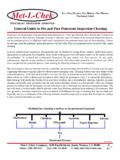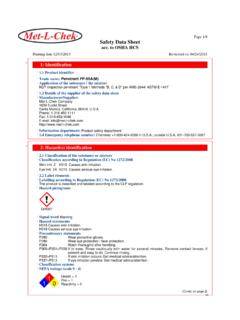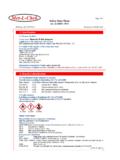Transcription of Guide to Penetrant Materials,1-13 - met-l-chek.com
1 Met-L- chek Guide to 1. 1/13. Penetrant Inspection Penetrant Profesor Approved Materials 2013. Met-L- chek Company has been manufacturing Penetrant inspection materials since 1952. Met-L- chek Company products are sold under the Met-L- chek and Pen- chek trademarks. Met-L- chek Company products are manu- . factured in the United States and under license in the Netherlands by NDT Europa Penetrant inspection is a surface inspection method used to highlight fine cracks, porosity, and through leaks on most solid surfaces. It is usable on most metals, some plastics, composites, and synthetic materials. Pen- etrants are of principally two types, visible red dye or fluorescent. Visible Penetrant inspection is performed in bright white light and fluorescent Penetrant inspection is performed in a darkened area under UV-A illumination.
2 Visible Penetrant indication Fluorescent Penetrant indications Fluorescent penetrants are available in sensitivity levels 1/2 to 4 with 4 being the highest. Visible penetrants are not generally classified by sensitivity level but are generally considered to be roughly equal to level 1 fluorescent Penetrant inspection. Penetrants are further classified as to their surface removal method; water washable, post emulsifiable, solvent removable, and special application. The other components of the process are emulsifiers, solvent cleaners and removers, and developers. Materials are available in bulk containers for production line operations, and portable aerosol cans and kits for remote and spot inspections.
3 The typical use temperature range is C to C (40 F to 125 F). 16 oz. (400ml) volume Bulk materials in 1 gal( ), 5 gal( ) and aerosol Penetrant inspection materials 55 gal(208L) containers In very simple terms the Penetrant inspection process consists of several steps: Step 1 - clean the inspection surface. Step 2 - apply Penetrant and allow it to penetrate the surface discontinuities. Step 3 - remove surface Penetrant and dry surface if water is used. Step 4 - apply developer and allow time for indications to form. Step 5 - inspect. Met-L- chek Company, 1639 Euclid Street, Santa Monica, California, 90404, Phone: 310-450-1111, Fax: 310-452-4046, Email: Web: Met-L- chek Guide to 2. 1/13. Penetrant Inspection Penetrant Profesor Approved Materials 2013.
4 High quality inspection materials are qualified to AMS-2644 and listed on QPL-2644 (Qualified Products List). The sensitivity of a Penetrant per AMS-2644 is established by Wright Patterson AFB Materials Laboratory, not by the Penetrant material supplier. Another specification based on AMS-2644 but with some minor differences is ISO-3452-2, which finds use in Europe for generally non aerospace applications. All major aerospace OEM's require a material be listed on the QPL for AMS-2644 before it may be considered for use. There are numerous processing specifications for the Penetrant inspection process, the major ones are ASTM. E-165 and ASTM E-1417 for most general applications, AMS-2647 for aerospace applications, and the ASME.
5 Pressure Vessel and Boiler Code for nuclear and power generation applications. Many OEM's have their own processing specifications which include portions of one or more of the above mentioned specifications. In aero- space, to try to simplify the number of individual OEM specifications a user would have to try to comply with, an organization called NADCAP was created as a central audit authority. A user is either working to an OEM's specification, a consensus specification such as ASTM E-1417, a customers specification, NADCAP, or their own procedure. A written procedure should be available to anyone required to perform Penetrant inspection. Penetrant material Definitions AMS-2644 and ASTM E-1417 ISO-3452-2.
6 TYPE 1 Fluorescent Dye TYPE I Fluorescent Penetrant : Sensitivity levels 1/2 4. Sensitivity levels 1/2 4. TYPE 2- Visible Dye TYPE II- Color Contrast Penetrant No sensitivity levels. Sensitivity levels 1-2. TYPE III Dual fluorescent & visible Sensitivity per visible levels Method A Water washable. Method A Water washable. Method B Post-emulsifiable, lipophilic. Method B Lipophilic emulsifier. Method C Solvent-removable Method C Solvent. class 1 Halogenated. class 1 Halogenated class 2 Non-halogenated. class 2 Non-halogenated. class 3 Special application class 3 Special application Method D Post-emulsifiable, hydrophilic Method D Hydrophilic emulsifier. Method E Water and solvent Developer Forms Developer Forms a dry powder.
7 A dry powder. b water soluble. b water soluble. c water suspendible. c water suspendible. d non-aqueous (solvent) for Type 1 penetrants. d non-aqueous for Type I. e non-aqueous (solvent) for Type 2 penetrants. e non-aqueous for Type II & III. f special application. f special application. Met-L- chek Company, 1639 Euclid Street, Santa Monica, California, 90404, Phone: 310-450-1111, Fax: 310-452-4046, Email: Web: Met-L- chek Guide to 3. 1/13. Penetrant Inspection Penetrant Profesor Approved Materials 2013. Product Guide AMS-2644 QPL. Product Type Methods Sensitivity Form Class D-70 1&2 A, B, C, & D 1/2 - 4 d&e NA. D-72A 1 A, B, C, & D 1/2 - 4 a NA. D-76B 1 B, C, & D 1/2 - 4 b NA. D-78B 1&2 A, B, C, D 1/2 - 4 c NA.
8 E-50 2 B NA NA NA. E-57 1&2 B 1/2 - 4 NA NA. E-58D 1 D 1/2 - 4 NA NA. E-59 1&2 C 1/2 - 4 NA 2. E-59A 1&2 C 1/2 - 4 NA 2. R-503 1&2 C 1/2 - 4 NA 2. R-504 1&2 C 1/2 - 4 NA 2. FBP-911 1 A&C 1 NA NA. FP-921 1 A&C 1 NA NA. FBP-912 1 A&C 2 NA NA. FP-922 1 A&C 2 NA NA. FBP-913 1 A&C 3 NA NA. FP-923 1 A&C 3 NA NA. FBP-914 1 A&C 4 NA NA. FP-93A(M) 1 B, C, & D 2 NA NA. FP-95A(M) 1 B, C, & D 3 NA NA. FP-97A(M) 1 B, C, & D 4 NA NA. VP-30 2 A&C NA NA NA. VBP-300 2 A&C NA NA NA. VP-31A 2 B&C NA NA NA. Choosing Fluorescent (Type 1) Water Washable (Method A) Penetrants Water washable penetrants are the most widely used for general metal working and even low stress component aerospace applications. Water washable penetrants are composed of water washable ingredients.
9 The Penetrant covered part is simply washed after the prescribed penetration dwell time. Being water washable, excessive wash time or pressure must be avoided with Method A penetrants to avoid washing the Penetrant from shallow open discontinuities. The FBP-911, FBP-912, FBP-913 and FBP-914 series covers sensitivity levels 1-4 and was designed to be the most environmentally friendly possible. This series does not contain fats, oils, or greases (FOG's), and is free of any volatile organic compounds (VOC's). The constituents are considered biodegradable. This series is smooth washing, non-gel forming and will wash cleanly from rough surfaces. The FP-921, FP-922 and FP-923 series covers sensitivity levels 1-3.
10 These materials are bright yellow green fluorescent penetrants that are smooth washing, with controlled removal without gelling. They have low viscosi- ties, which aids in spraying and reduced drag out in immersion applications. The materials use biodegradable surfactants. They are approved by GE, Pratt & Whitney, and Rolls-Royce for non rotating turbine engine com- ponent inspection. Met-L- chek Company, 1639 Euclid Street, Santa Monica, California, 90404, Phone: 310-450-1111, Fax: 310-452-4046, Email: Web: Met-L- chek Guide to 4. 1/13. Penetrant Inspection Penetrant Profesor Approved Materials 2013. FLP-1 is a special water based leak detector Penetrant which may be used as supplied or diluted with water for special applications in through-leak detection, use on plastics and other chemically sensitive materials.






